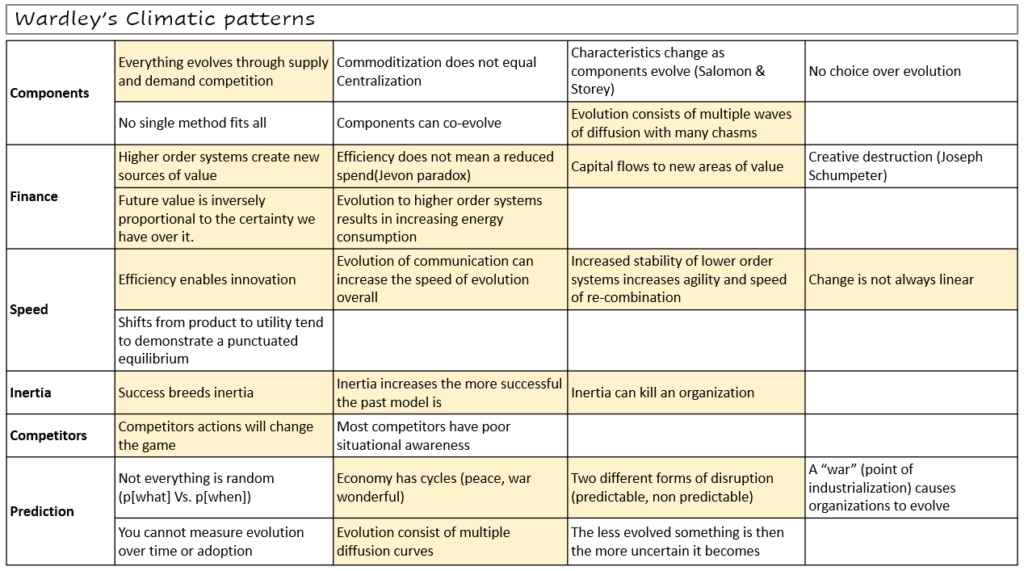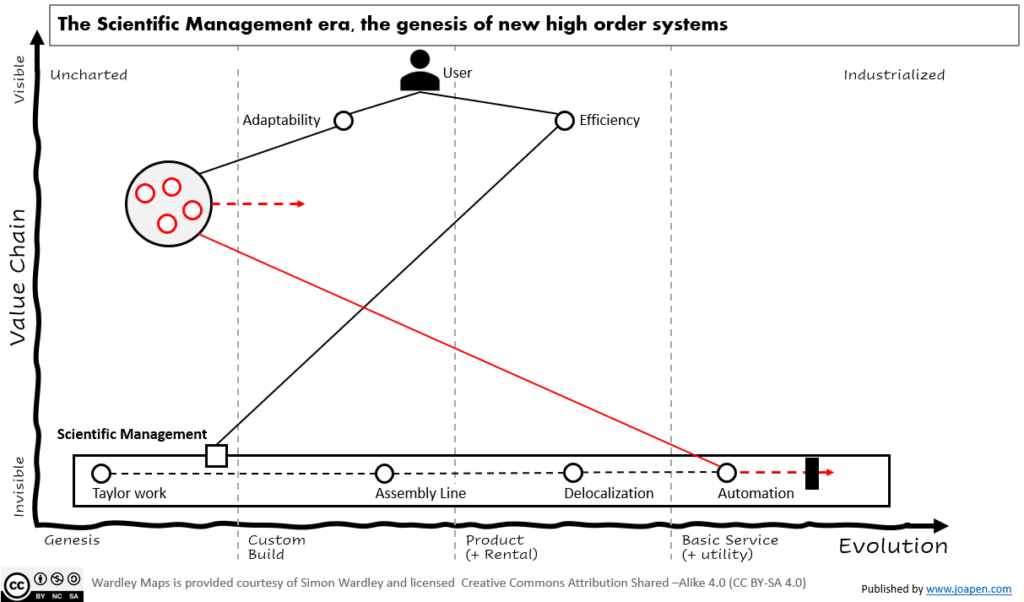The Principles of Scientific Management
In 1898, Frederick Winslow Taylor joined a steel factory in Bethlehem (Pennsylvania, US) which had a capacity problem. He did not limit his work to get the problem solved, but extended his work beyond. He performed different empirical tests on cutting speeds, being able to quadruple the speed of steel cuts.
He extended this approach to many different aspects of the factory.
In 1900 during the Universal Exposition in Paris, Taylor presented his approach and results. The people attending the conference checked the results and classified them as a miracle. The norm was to cut nine feet of steel per minute; Taylor’s system could cut fifty. Some people did not believe his numbers.
In the exposition industrial manufacturing was the sexy technology of the moment, and you can figure out Taylor’s presentation as the one did by Steve Jobs’s when he introduced the first iPhone.
Taylor’s success represented the legitimization of “management” as a discipline. Under Taylor’s formulation, managers were both research scientists and architects of efficiency.
The notion of top-down, rigidly predetermined, managers Vs workers, division of the work, specialization, etc… was all documented on a paper called “The Principles of Scientific Management”.
The “Scientific Management” was born.
Everybody should know who Taylor is
After that, so many business people were visiting the steel factory in Bethlehem, asking Taylor about how to implement these principles and United States thrived in the way we all know.
One of the principles described by Taylor was his philosophy of replacing the intuition of the person doing the job with reductionist efficiencies designed by a separate group of people marked a new means of organizing human endeavors. Does it sound it familiar to you today?
Henry Ford’s famous assembly line, was a natural extension of Taylor’s train of thought, even do that he told everybody that he did not apply those principles.
The rates of manufacturing factories in US between 1915 and 1965 (50 years) had not competitor across the world.
So when you wake up, think about all you do in a daily basis, all you consume and how the invisible hand of the work done by Taylor is almost present in all.
Everything evolves from Genesis to Utility
Scientific management has evolved since it was formally introduced in 1911 to the American Society of Mechanical Engineers (ASME).
What is the situation right now? Well, I think it’s at the utility stage, mainly by these factors:
- High rates of automation in almost all parts of the supply chain.
- Low margins due to a high competitive market.
- High pressure to increase these low margins in the short term (specially public companies on a quarter by quarter basis).
- Inheritance of high volume of technical debt (yes, technical debt is not only a software issue).
- Localization of major factories are already in low cost locations.
I have created this basic map to visualize it:

Let’s review some climatic patterns
This table below is a set of climatic patterns proposed by Simon Wardley after a research he did around 2005. I have highlighted some I think are relevant:

Some brief comments on the highlighted ones:
- Everything evolves through supply and demand competition: As we have seen, after 100 years of evolution of the scientific management, competition have evolved in so many ways.
- Evolution consists of multiple waves of diffusion with many chasms: This can be seen in the different periods of the manufacturing industry, with trends related to automation, delocalization, and many other efficiencies.
- Higher order systems create new sources of value: we can see it continually, right now we have additive manufacturing, chemputation, IoT….
- Efficiency does not mean a reduced spend(Jevon paradox): The amount of energy spent continues increasing and the forecasts for 2050 are extremely dangerous if we continue using fossil based energy.
- Capital flows to new areas of value: due to the new high order systems that are being created.
- Future value is inversely proportional to the certainty we have over it: So many people think that some of the new high order systems are ridiculous and they will not evolve in the future. They are right on some of them, but some others will survive.
- Evolution to higher order systems results in increasing energy consumption: as mentioned before, the estimations of energy consumptions for 2050 are higher than today.
- Efficiency enables innovation: there are so many innovative initiatives, some isolated, some others under a major initiative.
- Evolution of communication can increase the speed of evolution overall: this factor is critical in a hyperconnected world.
- Increased stability of lower order systems increases agility and speed of re-combination: this is critical for the creation of new technologies as you can focus your resources on the innovation side of the initiative, not on operational issues of a low order system.
- Change is not always linear: we cannot pretend to forecast when things are going to happen.
- Success breeds inertia: almost all manufacturing industry is repeating the reductionist management model, and hence they are being moved by inertia. This does not only is applicable to manufacturing industry, this can be extended to many other sectors.
- Inertia increases the more successful the past model is: as the manufacturing companies, specially the public ones, are giving dividends to their shareholders, and they have feed this for decades, now they have no space for investing in innovation.
- Inertia can kill an organization: it’s happening during last 30 years, just look at the amount of merges done between major manufacturing companies, resulting is destruction of a lot of value that is hidden under the papers.
- Competitors actions will change the game: Look at Tesla, they are doing the things differently, and while 10 years ago the automobile industry laugh out laud of Elon Musk, now they are trying to copy what he created.
- Economy has cycles (peace, war wonderful): manufacturing industry has been in war for decades.
- Two different forms of disruption (predictable, non predictable): We can predict that AI is going to be part of our future (well, it’s already part of our lives), but no when this is going to be massively extended.
- Evolution consist of multiple diffusion curves: manufacturing have lived so many diffusion curves, and more are coming, but future ones will come from a different form of disruption. Which one? Sorry, I do not know.
Why are you reviewing all these climatic patterns in detail? Well, I was reading and writing while thinking about the situation. Probably this is not useful for the reader, but it’s my way to define a pre-mortem analysis that I can review in future (post mortem).
We do not live in an isolated world anymore
In the beginning of 20th century, the world was so much isolated in you compare it with 2022. This is an aspect that we forget in our daily basis. Right now I’m reading to my 6 years old son “Around the World in Eighty Days” (Julio Verne, 1872), where Phileas Fogg did his travel in all that time. Today you could technically travel around the world in hours, connect with people around the world in many different ways and many other things.
On this context, with a networked world, reductionist management is ineffective and has its limits on an industry that is very matured: the user is asking for different things with a faster time response.
So ok, we do not have an efficiency problem, what happens then?
We have an adaptability problem.
On this situation, we can conclude that we all have a new problem, a major one. I have represented it as follows:

To solve the problem of adaptability, some institutions, companies, organizations and individuals (represented in genesis in red color) are focusing on new practices, technologies and ways of working that enables them to have a better adaptability into a world that changes faster and faster.
Some basic examples:
- What Tesla is doing in the automobile industry: killing the traditional competitors in terms of speed of delivery and innovation.
- Agile methodologies for managing complex software systems.
- Millions of start-ups that are trying to do the things in a different way, taking advantage of “scientific management” rigidity.
- The evolution of some industries from a generalist solver to a individual solution solver (pharma).
- Companies as Meta (Facebook), Amazon, Alphabet (Google), that do not pay dividends because they think they have to continue investing in innovation and for the long term they do not want to fall in the “dividend trap”.
What do all these companies/organizations have in common?
The major companies and organizations that are being able to escape of the scientific management and its reductionist approach have something in common: they have a long term purpose a moral imperative.
Some examples I see:
- Alphabet: they want to increase the life expectancy (look at the investments in healthcare they are doing under “X” Company).
- Tesla: it’s part of Mission Mars (Elon Musk long term initiative).
- China: they want to protect and extend their sovereign (their population and governors perfectly remember how much times China has been invaded in the past and they will not allow it easily).
Summary
Maybe I’m being too pedant, but I think that “the scientific management and the reductionist approach” era is showing signs of deterioration.
Is the end of scientific management? I don’t think so, but we all should look at the things at the right perspective from time to time, and think that “Scientific Management” is very matured and has some signs of deterioration that are not compatible with our needs.
As usual, feedback is welcomed!